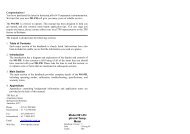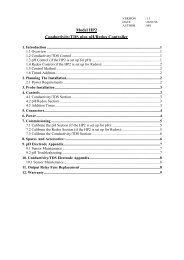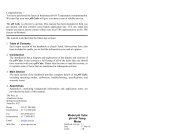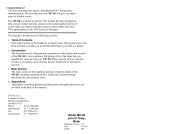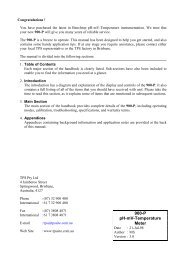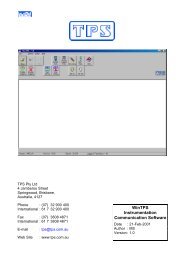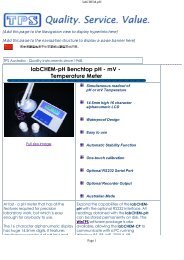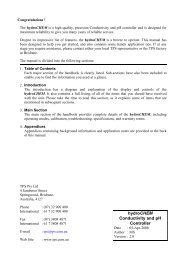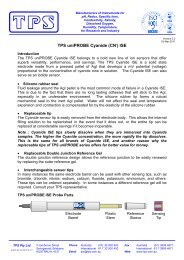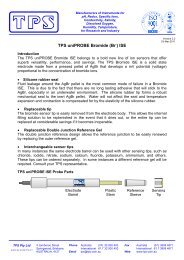900-C Conductivity, TDS, Resistivity, Ratio, Meter - TPS
900-C Conductivity, TDS, Resistivity, Ratio, Meter - TPS
900-C Conductivity, TDS, Resistivity, Ratio, Meter - TPS
Create successful ePaper yourself
Turn your PDF publications into a flip-book with our unique Google optimized e-Paper software.
17.3 Calculating the ATC Slope of SolutionsThe conductivity of all solutions changes as the temperature of the solution changes. The ATCSlope of a solution is the amount that this <strong>Conductivity</strong> changes per degree Celsius. The ATC Slopeis dependant upon the chemicals dissolved in the solution, the concentration of those chemicals, andthe actual temperature of the solution. Consider the following examples…• A 0.02 Molar solution of KCl has a different ATC Slope to a 0.02 Molar solution of NaCl.• A 0.02 Molar solution of KCl has a different ATC Slope to a 0.01 Molar solution of the samesalt.• A 0.02 Molar solution of KCl at 25 O C has a different ATC Slope to a 0.02 Molar solution ofKCl at 15 O C.To calculate the ATC Slope of a solution…1. Set the ATC Slope for sample measurements to zero, with the following key sequence…→ F5:Configure → F3:ATC → F1:Sample → 0.00 →2. Ensure that the temperature function has been calibrated (see section 7.1). The conductivityfunction does not need to be calibrated at this point.3. Warm or cool the solution to approximately 5 O C below the temperature at which you expect totake sample measurements. Record the <strong>Conductivity</strong> and Temperature readings, once both havebecome stable.4. Warm the solution to approximately 5 O C above the temperature at which you expect to takesample measurements. Record the <strong>Conductivity</strong> and Temperature readings, once both havebecome stable.5. Apply the following formula, where C1 and T1 are the first readings taken, and C2 and T2 arethe second readings taken…C2Log C1T2 - T1ATC Slope = 100 x 10 - 16. Enter the result that is obtained as the ATC Slope of the solution.(a) If this is the ATC Slope of the sample solution to be measured…→ F5:Configure → F3:ATC → F1:Sample → [result] →(b) If this is the ATC Slope of the standard solution to be used for calibration…→ F5:Configure → F3:ATC → F2:Standard → [result] →NoteTo assist in calculating the ATC Slope the following information can be entered into a spreadsheet.This example has been specifically written for Microsoft® Excel®, although the syntax should besimilar for other spreadsheet software.49AB1 <strong>Conductivity</strong> 1 2 Temperature 1 3 <strong>Conductivity</strong> 2 4 Temperature 2 5 ATC Slope =100*((10^((LOG10(B3/B1))/(B4-B2)))-1)



